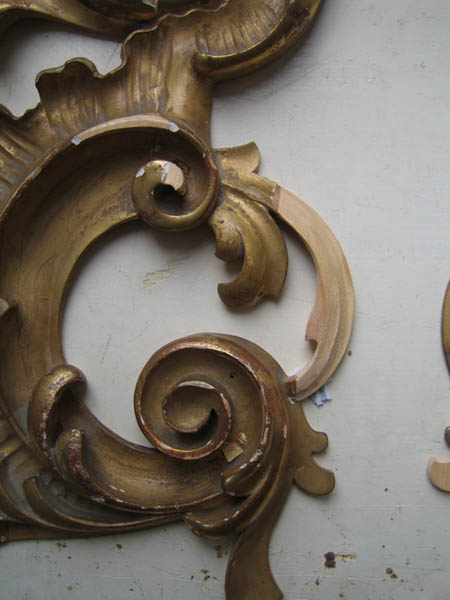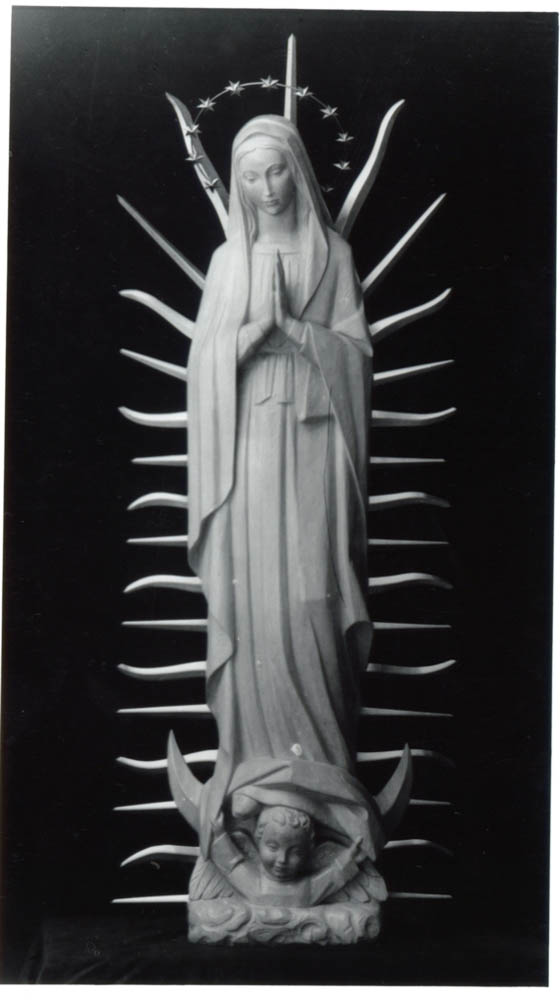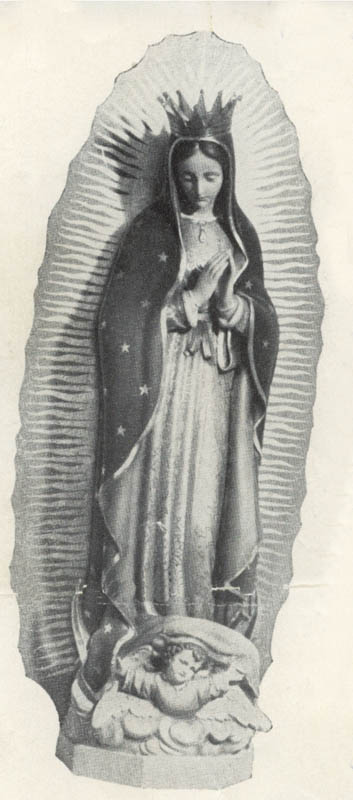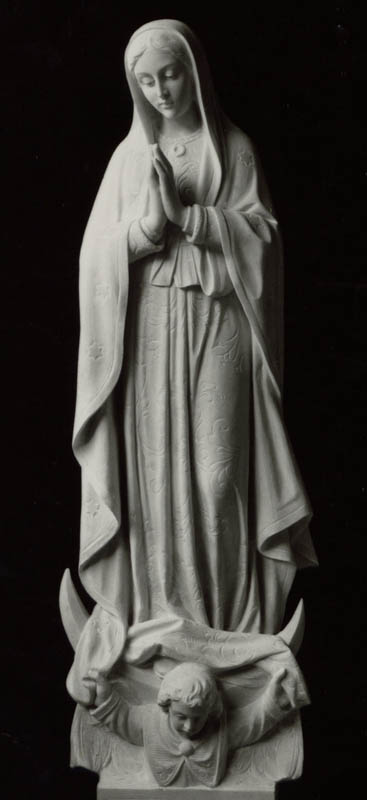THE
WOODCARVING GLOSSARY |
||||
| |

|
|||
| Bronze
sculpture
|
Bronze
is ideal for casting art works; it flows into all crevices of a mold,
thus perfectly reproducing every detail of the most delicately modeled
sculpture. It is malleable beneath the graver’s tool and admirable
for repoussé work. The Egyptians used bronze, cast and hammered,
for utensils, armor, and statuary far in advance of the Bronze Age in
Europe. The Greeks were unexcelled in bronze sculpture. The Romans took
quantities of bronze statues from Greece and made thousands themselves.
They employed bronze for doors and for furniture, utensils, and candelabra,
of which some were recovered at Pompeii and Herculaneum.
|
|||
| Cire
perdue - Lost wax system
|
Cire
perdue [Fr.=lost wax], sculptural process of metal casting that may be
used for hollow and solid casting. The sculptor makes a model in plaster
or clay that is then coated with wax. This model is then covered with
a perforated plaster or clay mold. When heated, the mold will –lose” the
wax (hence the name of the method) as it runs out of the holes in the
plaster. Molten lead is then poured into the space formerly occupied by
the wax. After the work cools, the sculptor breaks the mold, removes the
plaster core, and files or polishes the metal product. One can also make
hollow sculptures by piece-casting, which, as its name suggests, involves
the construction of a work in pieces rather than as a whole. The most
important advantage of the lost-wax method is that it eases the casting
of a sculpture with elaborate curves.
|
|||
| Color
|
Color
is the effect produced on the eye and its associated nerves by light waves
of different wavelength or frequency. Light transmitted from an object
to the eye stimulates the different color cones of the retina, thus making
possible perception of various colors in the object.
|
|||
| Decorate
|
To
plan and execute the design, furnishings, and ornamentation of the interior
of (a house, church, apartment, etc.), esp. by selecting colors, fabrics,
and style of furniture, by making minor structural changes.
|
|||
| Drawing
|
Drawing
is the art of the draftsman. In its broadest sense it includes every use
of the delineated line and is thus basic to the arts of painting, architecture,
sculpture, calligraphy, and geometry. The word drawing is commonly used
to denote works in pen, pencil, crayon, chalk, charcoal, or similar media
in which form rather than color is emphasized. For centuries drawings
have been made either as preparatory studies or as finished works of art.
Preparatory drawings sometimes reveal a vigor and spontaneity lacking
in the completed work.
|
|||
| Engraving
|
Engraving,
in its broadest sense is the art of cutting lines in metal, wood, or other
material either for decoration or for reproduction through printing. In
its narrowest sense, it is an intaglio printing process in which the lines
are cut in a metal plate with a graver, or burin. Furrows are cleanly
cut out, raising no burr, and then filled with ink which is transferred
under high pressure to the printing surface of the press.
|
|||
| Gilder
|
The
specialised artist who covers the woodcarvings with gold.
|
|||
| Intarsia
- wood inlaying
|
Intarsia
or tarsia is a proper a form of wood inlaying. The term is sometimes applied
to inlays of other materials such as ivory and metal. It is differentiated
from marquetry by the basic veneering process of the latter. The term
intarsia is specifically applied to a type of inlaying probably developed
in Siena, Italy, in the 13th cent. and derived from Middle Eastern inlays
of ivory upon wood. This art was widely practiced in Italy from c.1400
to c.1600. The fashion for intarsia declined thereafter, although some
works in this medium were still produced. Intarsia work was also practiced
to a limited extent elsewhere in western Europe. Designs included pictorial
scenes and conventionalized scrolls, arabesques, and geometric forms.
|
|||
| Painter
|
The
artist who covers the woodcarving with paint.
|
|||
| Painting
|
Painting,
direct application of pigment to a surface to produce by tones of color
or of light and dark some representation or decorative arrangement of
natural or imagined forms. |
|||
| Relief
|
Relief,
in sculpture, is a three-dimensional projection from a flat background.
In alto-relievo, or high relief, the protrusion is great; basso-relievo,
or bas-relief, protrudes only slightly; and mezzo-relievo is intermediate
between the two. Ancient Egyptians and Etruscans also used cavo relievo,
intaglio, or sunken relief, in which the design is incised deeper than
the background. High relief, although also used in ancient times, reached
its climax in the baroque period. Bas-relief is commonly employed on coins
and on medals.
|
|||
| Restoration
|
Art
conservation and restoration, the preservation of structurally sound works
of art, the halting of processes that lead to the damage of works of art,
and the repair of already damaged works of art.
|
|||
| Sculptor
- Woodcarver
|
A person
who practices the art of sculpting a material like wood.
|
|||
| Sketch
|
A
rapidly executed kind of pictorial note-taking. The sketch is not usually
intended as an autonomous work of art, although many have been considered
masterpieces in their own right. Used extensively in the planning of large,
complex projects, the sketch allows the artist to visualize quickly the
bend of a knee or the sweep of an arm without having to experiment directly
on the work itself.
|
|||
| Tempera
|
Tempera
is a painting method in which finely ground pigment is mixed with a solidifying
base such as albumen, fig sap, or thin glue. When used in mural painting
it is also known as fresco secco (dry fresco) to distinguish it from the
buon fresco (true fresco) applied to damp walls. The name distemper is
given to the method when a glue base is involved. When used on wood panels,
as it most frequently was for altarpieces and other easel pictures, it
was applied on a gesso underpainting that was smooth, very white and brilliant.
Tempera's particular advantage is that clear, pure colors are produced,
which are not so subject to oxidation as are oils. However, tempera does
not lend itself to the expression of nuances of color and atmosphere.
|
|||
| The
art of woodcarving
|
Wood
carving, as an art form, includes any kind of sculpture in wood, from
the decorative bas-relief on small objects to life-size figures in the
round, furniture, and architectural decorations. The woods used vary greatly in hardness and grain. The most commonly employed woods include boxwood, pine, pear, walnut, willow, oak, and ebony. The tools are simple gouges, chisels, wooden mallets, and pointed instruments. Although they were universally one of the earliest art media, wood carvings have withstood poorly the vicissitudes of time and climate. |
|||
| Watercolor
painting
|
Watercolor
painting, in its wider sense, refers to all pigments mixed with water
rather than with oil and also to the paintings produced by this process;
it includes fresco and tempera as well as aquarelle, the process now commonly
meant by the generic term. Gouache and distemper are also watercolors,
although they are prepared with a more gluey base than the other forms.
Long before oil was used in the preparation of pigment, watercolor painting
had achieved a high form of sophistication.
|
|||
| Woodcarving
|
1.
the art or technique of carving objects by hand from wood or of carving
decorations into wood. 2. something made or decorated in such a manner. |
|||
HOW DO YOU TRANSLATE WOODCARVING / WOODCARVINGS IN OTHER LANGUAGES? |
||||
| |
eng -
Woodcarving / Woodcarvings deu - Holzschnitzerei / Holzschnitzereien ita - Scultura in Legno / Sculture in Legno esp - Escultura de Madera / Esculturas de Madera fra - Sculptures en Bois / Sculpture en Bois pol - Rzezba / Rzezby lit - medzio skulptura / medzio skulpturos please write to us and help us to add some other languages! Thank you! |
|||
Large
Photo Sample 1
Large Photo Sample 2
Large Photo Sample 3
Large Photo Sample 4
Large Photo Sample 5
Large Photo Sample 6
Large Photo Sample 7
Large Photo Sample 8
Large Photo Sample 9
Large Photo Sample 10
Large Photo Sample 11
Large Photo Sample 12
Large Photo Sample 13
Large Photo Sample 14
Large Photo Sample 15
Large Photo Sample 16
QUALITY
TRADEMARK OF THE WOODEN SCULPTURE
The trademark for wooden sculptures produced exclusively and entirely by hand.

In order to protect the sculptors of woodcarvings, which are exclusively produced by hand, the Chamber of Commerce of Bolzano has decided to certify the genuineness of this procedure. This certification is made in two successive stages: a trademark, duly registered, is attached to the object, and a certificate is issued declaring that it is entirely and exclusively hand-made.

The trademark,
which must be claimed, consists of a metal disc, bearing the inscription “ENTIRELY
HAND-CARVED”.
The application of the trademark is done by an expert chosen by the Chamber
of Commerce of Bolzano. After the work has been completed and carefully examined,
the expert issues the certificate, which is an official document of
the Chamber of Commerce, numbered progressively and containing all
the information necessary for the unmistakable identification of the woodcarving.
WHY
PRO
Quality:
Since its founding, the Art Studio has maintained a mission to preserve
the beauty and vitality of the sculpted works.
Tradition
und References:
Our long tradition has great value and is at the base of the work we still
carry out: the past helps us to avoid mistakes. We are also
sure that the given references give you trust.
Guarantee:
The Art Studio gives you a guarantee of 5 years in case of
natural decay (examples: color damage or clefts in the material). We do not
cover theft, fire, or mistreatment.
Flexibility:
The Art Studio has been working with hundreds of Churches in every part of
the World. It wants to satisfy the special needs Churches can have. We don’t
just offer you flexibility from us and our collaborators: we also offer you
flexibility of payment. You can gladly buy on installments with 0%
interest rate.
Professional
Assistance:
All our collaborators have a professional diploma in addition
to their years of experience. Additionally the Customer has the advantage
to be assisted and advised in technical terminology in three languages: English,
Italian and German.
CONTRA
Trust:
If you had more confidence in another studio or woodcarver, we can’t
stop you: the trust in the Artist is one of the most important pieces
in the Art mosaic.
Sale Price:
Like the quality, the Sale Price also has its explanations. Guaranteeing an incontestable
quality and the use of first class material, our Sale Price can in some cases overstep
the competitor’s Sale Price. If the competitors give you the same
warranty and inspires you the same trust at a cheaper Sale Price, we don’t
want to oppose. Don’t forget that the Sale Price reflects the value of the
work, which increases year for year.
Syntony:
Don’t take us into consideration, if we weren’t able to
be in syntony with your wishes or to satisfy your needs.
THE ART OF WOODCARVING IN VAL GARDENA
In the Dolomites,
not far from the Brenner Pass in Northern Italy, lies the Gardena
Valley. Its inhabitants are Ladin speakers, and, apart from the surpassing
beauty of the surroundings and its unique regional and linguistic characteristics,
this valley has a 300-year-old tradition in the art of woodcarving.
Because of the rough climate the soil of the valley yielded its inhabitants
a scanty livelihood, and so, the for the most part numerous families saw themselves
in need of other sources of support. Woodcarvers have been at work
in the valley since the fifteenth century.
Forests surround the valley and its stone pines provide the carvers with their
principal material. From scarcely inch-high figures to statues larger than
life-size, all come easily to the practiced hand of the Gardena carver, whose
heartfelt fervor and conviction bears witness to deep religious feeling.
Nowadays, sculptures
which are entirely and exclusively hand-carved are classified, get the trademark
for wooden sculptures produced exclusively and entirely by hand by
the experts of the Chamber of Commerce of Bolzano (Italy), which guarantees
the authenticity of the creations.
This trademark also informs customers about the authenticity of the work and
about the difference between unique creations and industrial wooden
figures, which are mass-produced on a pantograph milling machine.

CUSTOM MADE (HAND-MADE) VS. PRODUCED ON PANTOGRAPH
Recognize the difference between unique creations and products from the pantograph

To see the difference
doesn’t seem to be too hard– but in fact it is. Nowadays, through
advanced technology, it is hard for people who don’t know the first
thing about it. It is difficult to judge if a sculpture is entirely
hand-carved (so it is unique) or produced on a pantograph milling
machine (there are plenty of identical ones).
Firms or shops should always give their customers advice on how a sculpture
is carved. Dear Customer, always remember to ascertain the origin
of the woodcarving; e.g. the used method (hand or machine) and ask
for the certificate in case you bought a sculpture exclusively carved by hand.
Ours is a creation, not a production of woodcarvings.

INTERNATIONAL
STUFLESSER REFERENCES
We hope that this list of references can additionally raise the trust in us.
The Studio has realised several works, such as Altars, Statues and more also
in:
Rome (Italy),
Bendigo (Australia),
Manizales (Colombia).
Dacca (India),
Drempt (Netherlands),
Jerusalem (Israel),
Istanbul (Turkey),
Kula-Maui (Hawaii),
Lodz (Poland)
Miami (United States of America),
Natal (South Africa),
Olomouc (Czech Republic),
Sarajevo (Bosnia-Herzegovina),
Teganfu (China),
Timisoara (Romania),
Vienna (Austria).
Church Size Custom Statues, Altars, and Restorations
Cribs / Nativity Scenes / Church Statues
Crucifixion Groups and Church Interiors
CHURCH RESTORATION AND RENOVATION WORKS
HISTORY AND TRADITION - The Stuflesser Family
EXPOSITION DEPARTMENT - ARCHIVE
AWARDS - Sale PriceS AND HONOURINGS
CARDINAL ANGELO BAGNASCO'S VISIT
THE HOLY FATHER AND THE STUFLESSER ALTAR
CARDINAL TARCISIO BERTONE'S VISIT
THE EVOLUTION OF THE LOGO OF THE ART STUDIO
HOW CUSTOM CHURCH STATUES AND ALTAR DESIGNS ARE CREATED
Main Home Page of Custom Statues
More
Photos (click on photo to enlarge):
Contact - Address:
marianland.com
327 Main Street, P.O. Box 713
Blackshear, GA 31516
USA
Toll-Free Number: 1-888-778-5442 (USA & Canada) or 912-807-5480
E-Mail
Contact - Address:
marianland@marianland.com








